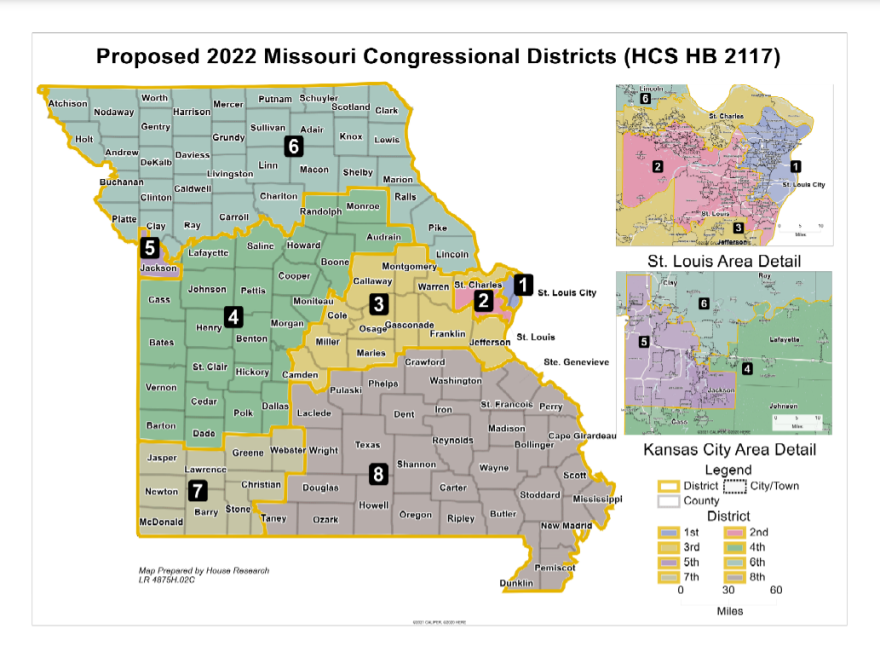Updated Jan. 27 with comments from Senate leadership
The Missouri Senate debate over the congressional redistricting map the House has already passed is now slated for next week after a faction of Republicans spent hours railing against the map both in committee and on the Senate floor.
Senate leadership said Thursday that negotiations over the map are ongoing, but they are “near a conclusion” on what it would take to pass it out of the chamber.
The likeliest changes would appear to be to the 2nd Congressional District, which is represented by Republican Ann Wagner and currently contains parts of St. Louis and St. Charles counties. Changes to the 3rd District, which includes Jefferson and Franklin counties, are also a possibility.
The makeup of the 2nd District is one aspect of the map that the seven-member Senate conservative caucus dislikes, arguing that it needs to be more Republican.
Sen. Bill Eigel, R-Weldon Spring, said on the floor Wednesday that not including more Republican areas in that district, such as more of St. Charles or Jefferson counties, makes the district a less safe Republican seat.
“If those trends continue, by the middle of the decade, this will be a seat that certainly leans Democratic,” Eigel said.
Some members of the caucus spent around five hours Wednesday speaking against the map on the Senate floor, including advocating for a 7-1 majority Republican map. For that to occur, the 5th District containing the Kansas City area would likely have to be split. According to Senate leadership, it’s not a likely outcome.
“In a 6-2 map, if that is in fact where we’re heading, I wouldn’t imagine a scenario where the 5th is carved up any different,” Senate Majority Leader Caleb Rowden, R-Columbia, said.
Sen. John Rizzo, D-Independence, said he was glad to hear that a 7-1 map appears to be off the table.
“Carving up Kansas City is an idea with no support, pushed by people with no support. They're burning a lot of bridges on their way to failure next week, hopefully,” Rizzo said.
The Senate could debate the map as soon as Monday.
Original story from Jan. 25:
A map redrawing Missouri’s congressional districts passed another hurdle as a Senate committee voted Tuesday to send two versions to the Senate floor for consideration.
By a vote of 9-5 on each, the redistricting committee advanced the House bill passed last week and a nearly identical Senate bill that also contains an emergency clause. That clause is needed for the maps to go into effect before the Aug. 2 primary. A previous attempt on the House side to add an emergency clause failed.
The maps themselves would likely keep Missouri’s current congressional makeup, sending six Republicans and two Democrats to Washington.
However, the committee debated and heard testimony on the bill for nearly three hours, with sharp exchanges between senators.
Sen. Bill Eigel, R-Weldon Spring, who has repeatedly stated his support for a map with seven Republican seats and one Democratic seat, pressed House bill sponsor Rep. Dan Shaul, R-Imperial, on his proposed map.
“When you refer to your map, you’re referring to it as a 6-2 map because you believe it will produce six Republicans and two Democrats. Is that correct?” Eigel said.
Shaul said that is a “fair assumption” but defended the process of creating the map.
“I’m drawing the best possible map for the state of Missouri. We can disagree whether it's a good map for the state of Missouri, and I think we do, and I think that's the crux of your questioning now,” Shaul said.
Dissatisfaction toward a 6-2 map continued to be a subject of discussion, especially from those who testified against the bills. No one spoke in favor of the maps, and almost all the testimony came from Republicans wanting a 7-1 map, with many centering party policies as a reason why.
Valinda Freed, a former vice-chair of the Missouri Republican Party, spoke in opposition to the 6-2 map.
“The people understand that they want people to go to Washington and fight for gun rights, for liberty, for families, and they want to know that you will go and do that and send people there,” Freed said.
Sen. Brian Williams, D-St. Louis, objected to using policy as a factor in considering how to draw Missouri’s districts.
“I don’t want this process to be tainted by partisan policy positions, which everyone is entitled to. I would rather us go through this process and do really what [it] is based on: focusing on districts that are compact, contiguous, in equal population, taking into account the Voting Rights Act,” Williams said.
In an atypical move, the committee acted on the bills the same day it heard testimony on them.
Sen. Denny Hoskins, R-Warrensburg, who voted against both bills, also spoke against voting the maps out the same day the committee heard public testimony.
“I think it would be a disservice to everyone that came here and testified against this bill to not take into consideration their thoughts, their comments, their testimony,” Hoskins said.
Unlike previous votes on the maps, the bills did receive some Democratic support, with two senators joining seven Republicans to advance the maps. Williams clarified in his “no” vote that he was advocating for a map more advantageous to Democrats.
“I think Missouri has a 60-40 electoral split, so I think a fair map would have three Democrats and five Republicans, so I’m voting no on this,” Williams said.
The Senate could take up the bill as early as Wednesday. A long debate is anticipated.






